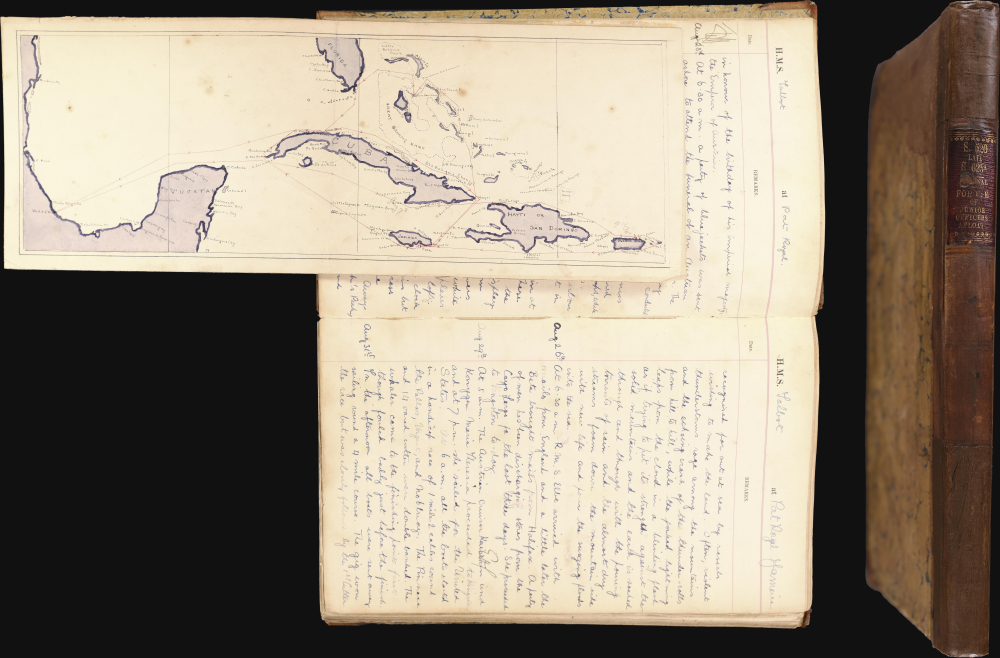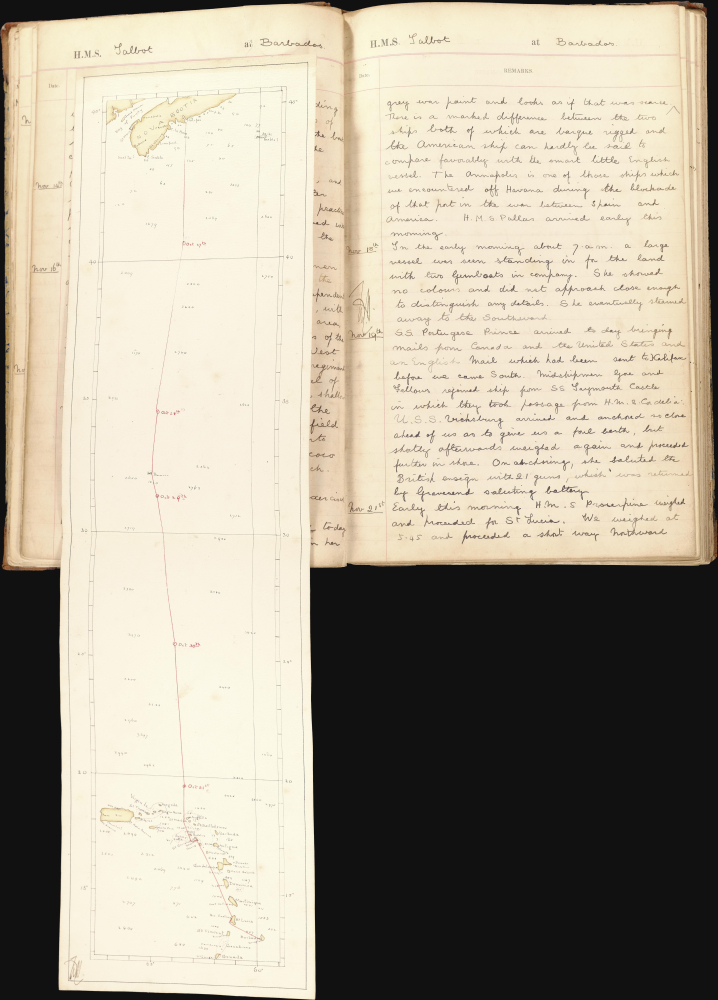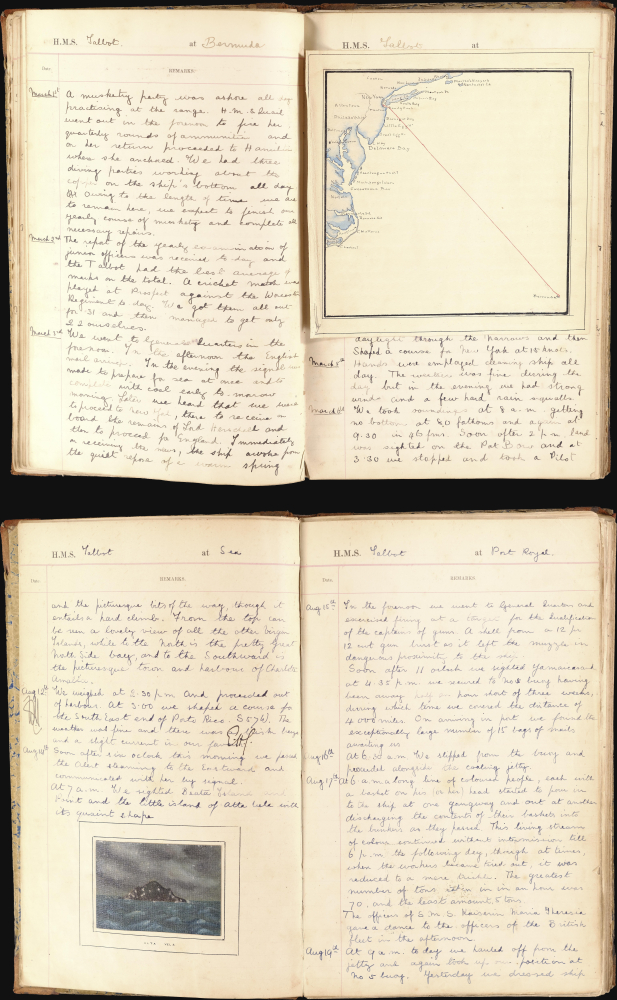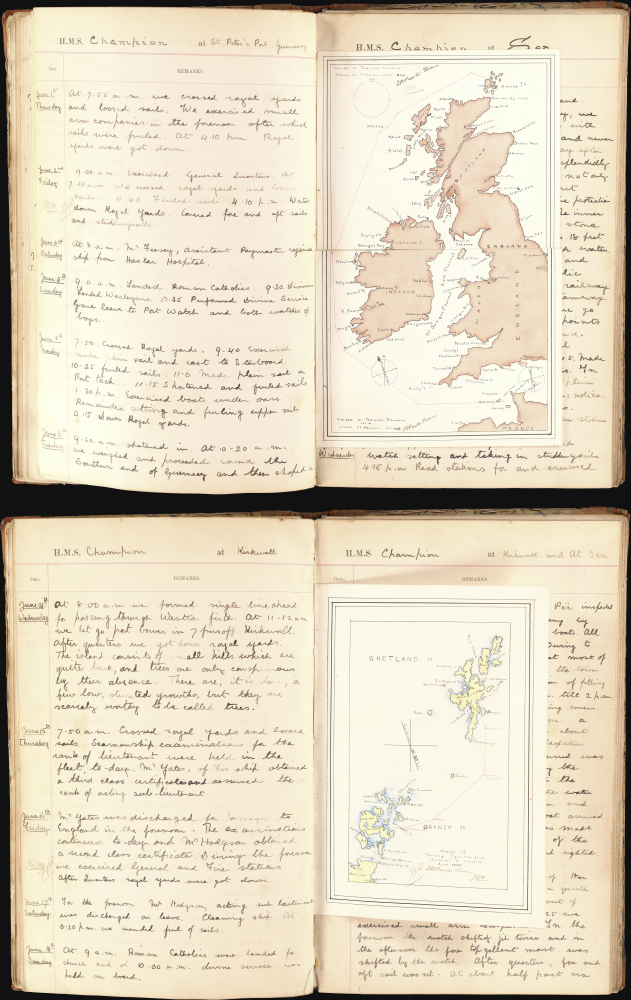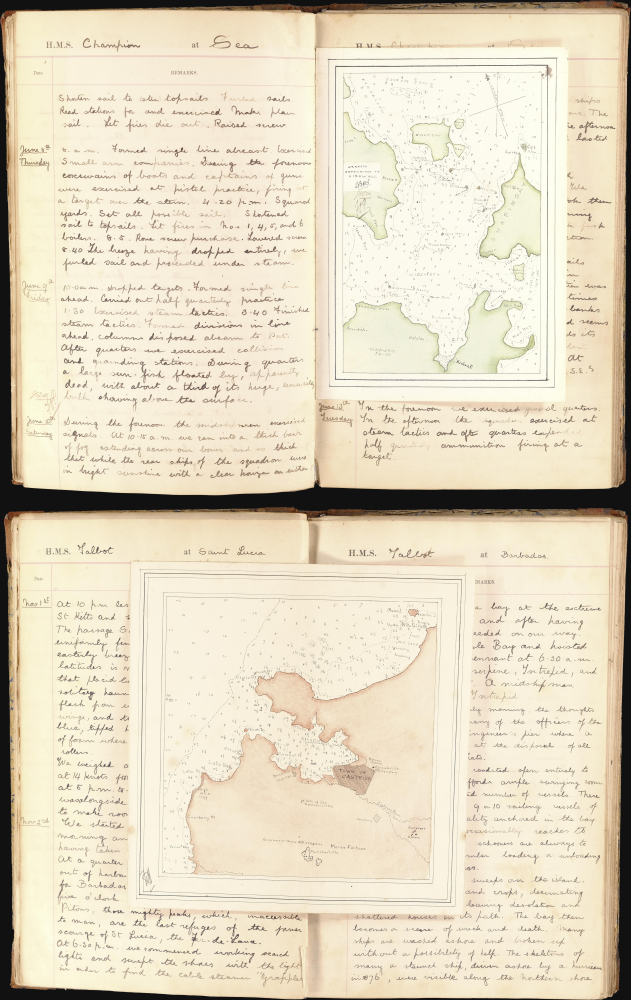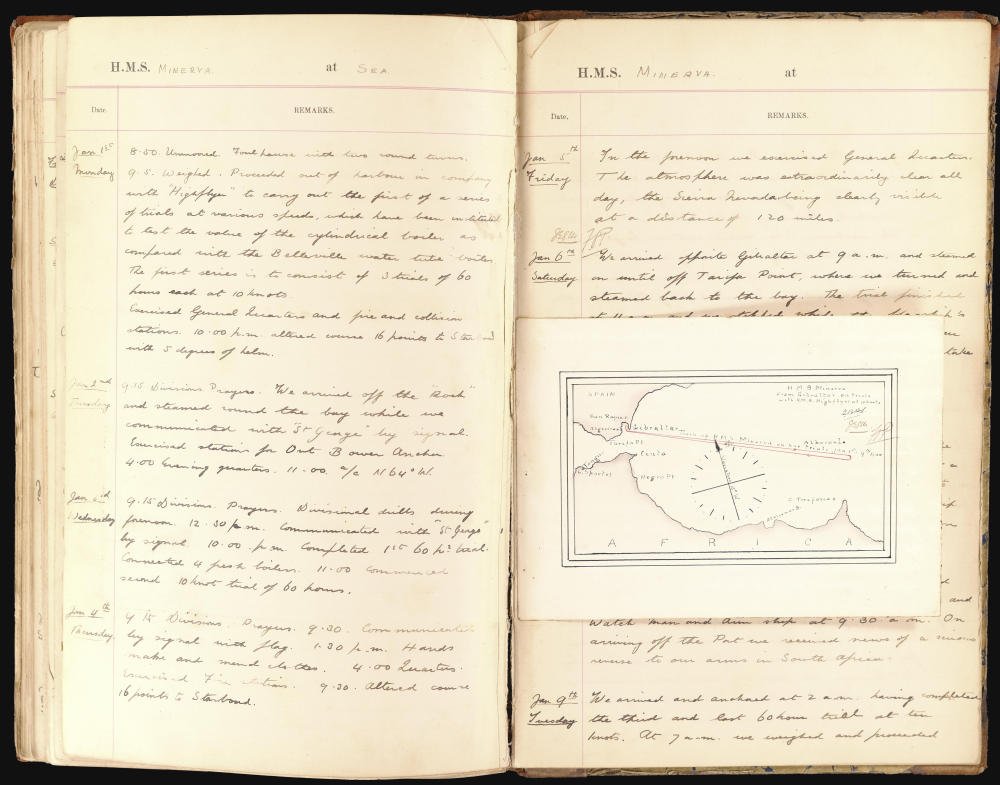1900 Preston-Thomas Personal Logbook of H.M.S. Talbot, Champion, Minerva
Logbook-prestonthomas-1900
Title
1900 (dated) 13 x 8 in (33.02 x 20.32 cm)
Description
A Closer Look
Quintin Bernhard Preston-Thomas served aboard the H.M.S. Talbot, H.M.S.Champion, and H.M.S. Minerva. This logbook covers from August 1, 1898, to January 14, 1900 (except for April 1899). Each month begins with a table that records the bearing and position at noon, wind direction and force, weather, barometer, speed, sea temperature, latitude, and longitude. The pages following include Preston-Thomas's day-to-day account of shipboard life in the Gulf of Mexico, the Caribbean, Canada, the English Channel, the British Isles, and the Mediterranean. The writing is eloquent, and some entries are extensive. Many of the entries recount places visited - highlights include- August 7, 1898: …A little later we saw the wreck of the Spanish cruiser, Christobel Colon, which, with a few bare and unsightly ribs showing above water, looked out of place in the peaceful scene and was a mournful example of the tragedy of war.
- December 25th, 1898, Christmas Day. The yard-arms and mastheads had their customary garlands of green but the mess deck was almost bare of the usual decorations. Being a Sunday all noise and singing in the afternoon was forbidden. Ashore the coloured people kept up the day with carol-singing, gaily coloured processions, etc. with impromptu bands compared with which the noises in a menagerie at feeding time would be tuneful.
- March 3th, 1899. …In the evening the signal was made to prepare for sea at once and to complete with coal early tomorrow morning. Later we heard that we were to proceed to New York, there to receive on board the remains of Lord Herschel and then to proceed to England. Immediately on receiving the news, the ship awoke from the quiet repose of a warm spring evening to activity and life
- March 6, 1899. …Soon after 2 p.m. land was sighted off the Port Bow and at 3:30 we stopped and took a Pilot on board. We then proceeded up the channel finally dropping anchor off Bedloe Island, on which the famous statue of Liberty stands , and at the same time saluted the American Ensign with 21 guns.
- March 7, 1899. At 6 a.m. we sent the funeral ashore and at 8:30 they returned with the remains of Lord Herschell which were placed in a. Sanctuary draped with cloth at the after end of the fore aft deck.
- March 20th, 1899. We weighed early and proceeded alongside South Railway Jetty. At 11 a.m. Lord Herschell's body was brought on deck and taken to the special train.
- October 31st 1899 H.M.S. Minerva at Chatham. At 9 a.m. Capt Pike commissions H.M.S. Minerva in the steam basin at Chatham. The officers and men of H.M.S. Champion, recently put out of commission, and a party from the Pembroke to make up the full complement, came on board at 9 a.m. to join. In the afternoon hands were employed provisioning ship. At 6 p.m. hands were told off for fire stations and exercised at fire quarters.
The Maps
Preston-Thomas tipped in 17 hand-drawn maps, many of which are signed 'Q.B.P.T.' These include:- A map of the Caribbean from Puerto Rico to Veracruz including the Virgin Islands and the Bahamas. A red line traces the H.M.S. Talbot's course through the region, which a reader could follow using Preston-Talbot's journal entries.
- A Map of Eastern Canada from Cape Breton Island to Montreal. A red line follows the Talbot's route from Halifax up the St. Lawrence River to Quebec City and Montreal and then back down the St. Lawrence to Dalhousie and back to Halifax.
- A map of Nova Scotia, Prince Edward Island, and Cape Breton Island. A red line highlights the Talbot's course from Charlotte Town to Halifax.
- A Map of Castries, Saint Lucia, and its Environs
- A Map from Nova Scotia to Barbados. A red line traces the Talbot's route from Halifax to Bridgetown.
- A Map of Bermuda and the Windward Islands. A red line traces the Talbot's course from Jamaica to Bermuda and back.
- A Map of the eastern United States and Bermuda. A line traces the Talbot's course from Bermuda to New York.
- H.M.S. Minerva Sheerness to Portland Nov. 29th-30th 1899.
- Ceruise of the Training Squadron May 22nd-23rd 1899. A red line traces the course of the Champion from Weymouth past Guernsey to Jersey.
- Voyage of the Training Squadron Jersey to Kirkwall June 1899. A red line traces the route of the Champion from Guernsey to the Orkney Islands
- A Map of the Orkneys Approaches to Kirkwall.
- Voyage of Training Squadron from Kirkwall to Lerwick. A red line traces the Champion's course.
- H.M.S. Minerva Portland to Spithead November 17, 1899. A red line trace the Minerva's course around the Isle of Wight.
- H.M.S. Minerva Portland to Gibraltar Dec 1899. A red line traces the Minerva's course.
- H.M.S. Minerva from Gibraltar on trials with H.M.S. Highflyer at 10 knots.
H.M.S. Talbot
The H.M.S. Talbot was built for the Royal Navy and commissioned on September 15, 1896. It was an Eclipse-class protected cruiser and served on the North America and West Indies Station (which included the Spanish-American War). She was redeployed to the China Station in 1901, where she served until at least 1904, when she witnessed a battle during the Russo-Japanese War (1904 - 1905). During World War I (1914 - 1918) she served in the English Channel in 1914 before heading to the Dardanelles to participate in the Battle of Gallipoli. She served in the area for the entire Gallipoli Campaign and helped cover the evacuation of Anzac Beach in December 1915 and Helles in January 1916. She spent the rest of the war off East Africa as part of the Cape Command. After the war, H.M.S. Talbot was stored in Cork Harbor from 1919 until 1921, when she was sold for scrap on December 6, 1921.H.M.S. Champion
H.M.S. Champion was a Royal Navy Comus-class corvette. She was built in Scotland and launched on July 1, 1878. Championsailed for East Asia and arrived in Amoy, China, in April 1886. She stayed in the Pacific with the China Station. During the 1891 Chilean Civil War, Champion was part of a joint force of American, British, French, and German warships that landed troops at Valparaiso, Chile, to protect their respective civilians and consulates. By 1899, Champion was back in Britain, serving as a training vessel. She continued to serve as a training vessel until World War I, when she was moored in the middle of the Thames between Cliffe Fort and Coalhouse Fort to control river traffic. She was sold for scrap on June 23, 1919.H.M.S. Minerva
The H.M.S. Minerva was an Eclipse-class protected cruiser and was completed on September 23, 1895. She served in the Channel Squadron before being transferred to the Mediterranean Fleet before December 1908, when she was part of the relief mission to Sicily after the December 28, 1908 earthquake and tsunami in the Strait of Messina. Minerva was transferred back to the United Kingdom in 1912. She began World War I in the Atlantic, pursuing enemy merchant shipping, and then transferred to the Mediterranean in November 1914 to support the 1915 Gallipoli Campaign. She transferred to the China Station in 1916 and, in 1917, was sent to the Indian Ocean and the Red Sea. Minerva ended the war off the coast of East Africa. She was sold for scrap on October 5, 1920.Publication History
This logbook/journal was handwritten by Quintin Bernhard Preston-Thomas between August 1898 and January 1900. Since it is a handwritten piece, it is unique.Cartographer
Quintin Bernard Preston-Thomas (November 10, 1880 - November 30, 1950) was a British career naval officer. Born in Weybridge, Preston-Thomas joined the Royal Navy in July 1894 and was assigned to the H.M.S. Britannia where he served until July 1896. In July 1896 he was promoted to Midshipman and transferred to the H.M.S. Talbot and served as part of her crew until March 1899 when he was transferred to the H.M.S. Champion. At that time the H.M.S.Champion was part of a training squadron and he served aboard the H.M.S. Champion until she was retired on October 30, 1899. Preston-Thomas transferred with the entire crew of the H.M.S. Champion to the H.M.S. Minerva, which was commissioned on October 31, 1899. Preston-Jones left the H.M.S. Minerva in January 1900, when he was promoted to Sub-Lieutenant. He was promoted to Lieutenant on April 1, 1902, and Lieutenant-Commander on April 1, 1910. He served aboard numerous ships from this point until World War I, when he commissioned and was given command of HMS M.33 on June 24, 1915 (now a museum ship at the National Museum of the Royal Navy). During his time commanding HMS M.33, he was deployed to the Dardanelles to cover the landing of reinforcements on the southern coast of the Gallipoli Peninsula. Preston Jones remained with HMS M.33 in the Aegean until May 1918. He retired from the Royal Navy with the rank of Commander on August 26, 1924. He married Marjorie Frances Rashleigh (1903-1989)April 4, 1923, with whom he had 1 son. More by this mapmaker...

